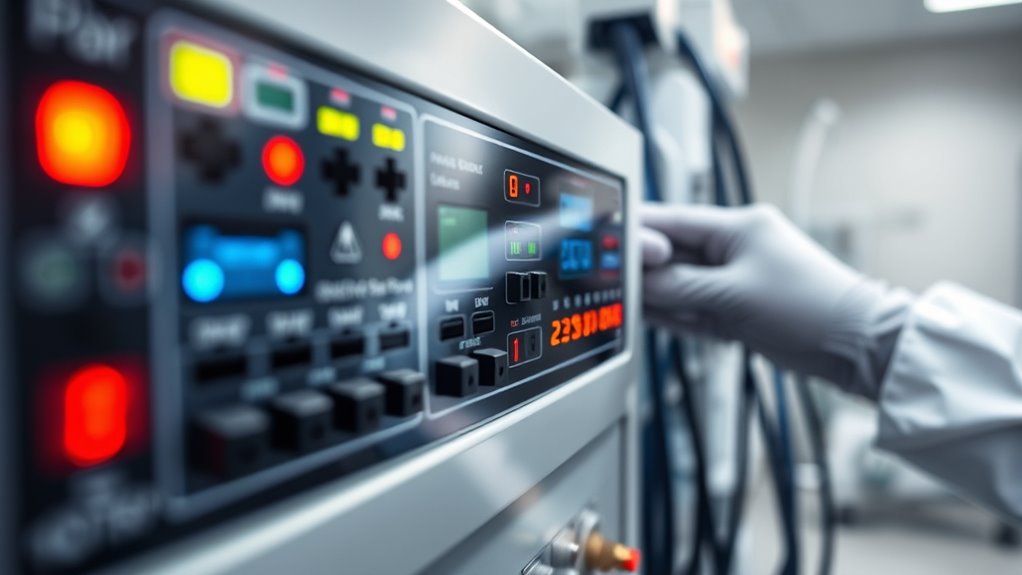Many believe that a device’s power supply doesn’t need regular checks or that batteries last forever, but these myths can lead to unexpected failures. True power planning involves monitoring battery health, scheduling routine maintenance, and understanding power quality impacts. Focusing on these vital practices helps prevent downtime, guarantees safety, and extends device life. Stay informed—exploring these essential factors can make a real difference in your maintenance approach.
Key Takeaways
- Regular power supply checks prevent silent damage and ensure device reliability, countering myths that ongoing maintenance isn’t necessary.
- Battery lifespan and health monitoring are critical to avoid unexpected failures and extend device uptime.
- Proper power planning includes firmware updates and managing power sources to maintain safety and performance.
- Neglecting routine maintenance increases risks of device failure, safety issues, and non-compliance with regulations.
- An ongoing, proactive maintenance strategy focused on battery care and performance data tracking enhances device dependability.
Common Misconceptions About Power Supply and Maintenance

Many people believe that once a medical device’s power supply is functioning properly, it doesn’t require regular maintenance. However, this misconception ignores critical factors like battery longevity and power quality. Over time, batteries degrade, reducing their capacity and risking unexpected failures during essential moments. Regular checks help ensure batteries stay reliable and maintain top performance. Additionally, power quality issues such as voltage fluctuations or surges can silently damage sensitive components, leading to costly repairs or downtime. Neglecting maintenance can compromise device accuracy, patient safety, and operational efficiency. You must see power supply upkeep as an ongoing process, not a one-time fix. Proper maintenance safeguards both your equipment’s performance and the well-being of those relying on it, especially considering that power quality issues can cause subtle yet significant damage over time.
Essential Facts for Effective Power Planning of Medical Devices

To guarantee your medical devices operate reliably and safely, understanding the key factors in power planning is essential. Proper planning involves knowing how battery longevity impacts device uptime, ensuring firmware updates don’t compromise power stability, and managing power sources efficiently. Here are critical facts to keep in mind:
Ensuring reliable, safe medical device operation requires understanding battery life, firmware updates, and power management.
- Battery longevity determines how often you’ll need replacements or recharges, affecting device availability.
- Firmware updates can influence power consumption; plan for updates that optimize energy use.
- Consistent power source management prevents unexpected downtimes and prolongs device lifespan.
Priorities for Optimizing Maintenance and Ensuring Device Reliability

Prioritizing maintenance tasks is essential to keep medical devices reliable and ready when needed. Focus on maintenance scheduling to prevent unexpected failures and extend battery longevity. Regularly check battery health and perform timely replacements to avoid power disruptions during critical procedures. Schedule maintenance based on device usage and manufacturer recommendations, ensuring that batteries are tested and calibrated consistently. Address potential issues proactively by tracking device performance data, enabling you to identify patterns that may affect reliability. Proper maintenance prioritization reduces downtime, minimizes costly repairs, and enhances overall safety. Keep a detailed maintenance plan that emphasizes battery management and routine inspections, so your devices remain dependable and compliant with standards. An understanding of Lifevest Advisors’ guidance can help inform effective maintenance strategies. Ultimately, an organized approach to maintenance maximizes device lifespan and guarantees optimal performance.
Frequently Asked Questions
How Often Should Medical Device Power Systems Be Tested?
You should test your medical device power systems at least annually to guarantee battery longevity and reliable performance. Regular testing protocols help identify potential issues early, preventing unexpected failures. If your device operates in critical environments or has a history of power problems, more frequent testing—every six months—may be necessary. Consistent testing maintains compliance, maximizes battery life, and ensures safety during essential operations.
What Are the Latest Innovations in Power Supply Technology?
Imagine you’re in the year 3000, and power tech has advanced beyond your wildest dreams. Today, innovations like solid-state batteries boost energy efficiency and extend battery longevity, making devices more reliable. Wireless power transfer and smart energy management systems optimize power use, reducing downtime. These breakthroughs mean fewer replacements and more dependable performance, ensuring your medical devices stay operational longer and safer, aligning with your needs for efficiency and longevity.
How Do Power Failures Impact Patient Safety?
Power failures can seriously threaten patient safety by disrupting essential medical devices. If you don’t have battery backups, critical equipment like ventilators and monitors may shut down unexpectedly. Surge protection helps prevent damage from voltage spikes, guaranteeing devices stay operational. Without these safety measures, patients risk compromised care, injuries, or even life-threatening situations. Always make sure your power systems include reliable battery backups and surge protection to safeguard patient well-being.
What Training Is Necessary for Maintenance Staff?
You need staff certification and safety protocols to keep maintenance staff sharp. Think of it as their superhero training—minus the capes, but just as essential. Proper training guarantees they understand power planning, troubleshoot effectively, and follow safety protocols to prevent mishaps. By certifying your team, you’re arming them with the skills to keep devices running smoothly and patients safe—because in this game, knowledge really is power.
How Can Data Analytics Improve Power Maintenance Strategies?
You can improve power maintenance strategies by leveraging predictive analytics and real-time monitoring. These tools help you identify potential issues before they cause failures, allowing you to schedule maintenance proactively. Real-time data gives you immediate insights into device performance, while predictive analytics forecasts future problems. Together, they optimize your maintenance plans, reduce downtime, and extend equipment lifespan, ensuring your medical devices operate reliably and efficiently.
Conclusion
Remember, “A stitch in time saves nine.” By debunking myths and focusing on essential facts, you can optimize your medical device power planning and maintenance. Prioritize reliability and proactive care to prevent costly downtime. Staying informed and vigilant guarantees your devices perform when it matters most. Don’t wait for problems to arise—address them early and keep your equipment running smoothly, because in healthcare, preparedness truly makes all the difference.









